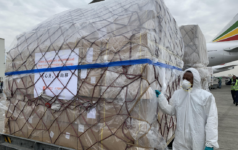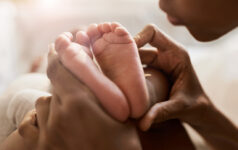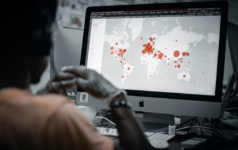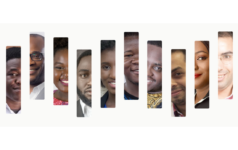The Ebola crisis provided a firsthand view into the stressors and breakdowns in procurement and supply chains under crisis conditions. From assuring quality control to enabling distribution, learn about best practices gleaned from past epidemics that could help with the COVID response.
Securing and appropriately allocating essential Covid-19 commodities in the coming 12-18 months will continue to be one of the biggest challenges that countries face, and even more so in low- and middle-income countries. High-income countries are struggling with overburdened healthcare systems and supply shortages. Stock-outs of soap, hand sanitizer, and disinfectants are common, and price gouging for off-the-shelf items is rampant.[1] Access to diagnostics is limited.[2] Shortages of personal protective equipment are putting healthcare workers at undue risk – which, in part, explains the high infection and mortality rates of healthcare workers in Italy.[3],[4] New York City alone anticipates it will require 30,000 additional ventilator machines, equivalent to about half of the global demand for new ventilators last year.[5] Modeling suggests that even in conservative scenarios for the spread of Covid-19 in low-income countries, critical care demand will outpace capacity 25 times over.[6] Given the current global outlook, the supply of commodities required to prevent additional spread and support healthcare delivery will continue to be strained. Without intervention, ethical concerns will grow, too, about widening inequality, as those countries, cities, and individuals who can afford it race to stock up on critical supplies.
We can learn several lessons from the Ebola crisis of 2014–2016, when we saw firsthand the stressors and breakdowns in procurement and supply chains under epidemic conditions. The Covid-19 pandemic differs from Ebola in that there is likely to be more innovation in vaccine development, diagnostics, and treatment, but also greater competition in acquiring the fruits of that innovation given the universal demand for it in high-income countries in addition to low- and middle-income countries. Still, there are a number of relevant lessons from Ebola that have bearing on our current moment:
- There is a need to efficiently link supply and demand and build trust between purchasers and producers. During the Ebola response, multiple different entities procured commodities with limited coordination – and sometimes competing approaches. For example, organizations prioritized personal protective equipment (PPE) suppliers differently, weighing “safety, price, ease of use, and breathability” in various ways.[7] Demand was unpredictable and fragmented, which made it difficult for suppliers to confidently ramp up production. Limited trust between suppliers and buyers, stemming from the amount of misinformation about demand in circulation, further compounded these issues.
- Clear guidance for suppliers and product quality control is critical. Product guidelines changed rapidly over the course of the Ebola crisis, which challenged suppliers to quickly adapt their products. For example, multiple organizations released conflicting PPE guidance that then evolved over time with user feedback and partner input.[8] In parallel, ensuring quality control amid evolving guidance and rapid product approvals was difficult. Reports of varying quality and condition of supplies sent to Liberia were common.[9]
- It is important to understand when to scale up use of an existing product vs. when a new product should replace it – like when products do not meet user needs or existing options are not scalable due to cost. Under immense pressure to meet demand and increase access to proven products, procurement agencies and implementing organizations purchasing commodities to combat Ebola largely relied on existing suppliers. Innovators and new suppliers struggled to enter the market due to lack of existing relationships and lack of experience navigating international purchasing processes.[10]
Reflecting on these lessons learned reveals the opportunity to more actively help shape the market for essential health commodities during Covid-19. Low- and middle-income countries will likely face several challenges operating on a country-by-country basis to carry out the following:
- Matching demand and supply: Understanding and aggregating demand, signaling to suppliers, potentially providing bridge funding and/or a guarantee to incentivize expanded production, and using analytics to determine distribution of products to where they are needed most.
- Managing pricing risks: Creating sustainable local markets, navigating price gouging and/or flooding of donated or low-cost products, and creating pricing guarantees for higher-cost products (e.g., ventilators, future vaccine).
- Assuring quality control: Expediting regulatory standards and certification, supporting rapid adoption of guidance, conducting quality assurance, and introducing and supporting new suppliers to increase capacity and spur innovation.
- Enabling distribution: Developing efficient logistics and building capacity of existing supply chains to enable delivery of additional commodities.
- Navigating growing global supply tensions: Operating in a time of export controls and identifying and/or scaling-up appropriate suppliers, including engaging new suppliers when needed and helping them enter low- and middle-income country markets.
Putting in place a proven market manager model has often helped to tackle these challenges globally in an efficient manner. A market manager can steward the overall commodity production and distribution process, drive global coordination, and lead an integrated system. Countries can share information and inform priority-setting. Taking those needs into account, the market manager can align and de-risk donors/implementing partners and manufacturers at the global level through data sharing, aggregated purchasing, market guarantees, and incentivizing research and development. The market manager function can also support coordination, funding, and capacity building for implementers across different countries and products by co-designing initiatives and facilitating learning between countries. Additionally, given that, in this scenario, demand for these commodities will far outstrip supply, a market manager can help to fairly allocate supply between countries to decrease the risk of furthering inequity. Several proven examples support this at both the country level (e.g., Nigeria’s National Strategy for Scale-up of Chlorhexidine, which identifies a national coordinating structure to coordinate procurement and distribution activities)[11] and the global level (e.g., Gavi’s partnership to aggregate vaccine purchases). These models demonstrate that coordination is possible when time and resources are invested.
In the context of Covid-19, a number of groups have stepped into similar critical coordination functions. Given the sheer number of products involved in the response, organizations already deeply involved in certain product areas (e.g., PPE, treatments, vaccines) are likely best suited to play a market manager role for their commodity. For example, the Pandemic Supply Chain Network (PSCN), co-chaired by the World Health Organization (WHO) and World Food Programme (WFP), and partners are ramping up to develop the global strategy for delivery of critical supplies, consolidate partner capabilities, minimize market disruption, receive direct country requests, and allocate distribution of supplies based on established principles.[12] PSCN has already started to organize accordingly with different groups leading on PPE, diagnostics, and medical equipment. ECRI has supported purchasing by matching vendors with country demands after countries receive World Bank funds across product categories.[13] And, the Clinton Health Access Initiative and PATH, with support from The Bill and Melinda Gates Foundation, is driving the coordination of supply chain and logistics efforts as well. This growing coordination capacity is a big step forward from the Ebola response, although the global community will need to continue to bolster it, especially as demand grows once treatments and vaccines come online.
In addition to coordination, proactive management capacity will need to grow to support prompt delivery of commodities to low- and middle-income countries. Active market management entails taking a market view to identify efficiencies where possible across commodity markets, proactively tracking and anticipating challenges and shortages in addition to responding to requests, supporting countries in determining commodity priorities given fixed budgets, and maintaining the ability to reallocate supplies as the situation evolves. Without this shift to active management, we risk missing opportunities in cross-commodity procurement, prioritizing based on requests and wealth rather than needs, and furthering inequity in the acquisition of life-saving products. Building this capacity will require further buy-in and collaboration from countries and partners, as well as clear mandates across agencies. Yet the lessons of past health crises suggest that this groundwork is essential. The global community needs to continue to empower collaboration efforts and ramp up proactive management quickly if we hope to ensure efficient procurement and equitable distribution of critical Covid-19 commodities.
To download a PDF of this article, click here.
FOOTNOTES
[1] Creswell. “’Where do I find your hand sanitizer?’ Sorry, we have none”. New York Times. Feb 29, 2020. Available from https://www.nytimes.com/2020/02/29/business/coronavirus-hand-sanitizer.html
[2] Manrai and Mandl. “Covid-19 testing: overcoming challenges in the next phase of the epidemic”. March 31, 2020. Available from https://www.statnews.com/2020/03/31/covid-19-overcoming-testing-challenges/
[3] WHO. “Shortage of personal protective equipment endangering health care workers worldwide”. March 3, 2020. Available from https://www.who.int/news-room/detail/03-03-2020-shortage-of-personal-protective-equipment-endangering-health-workers-worldwide
[4] Ranney, Griffeth, and Jha. “Critical supply shortages – the need for ventilators and personal protective equipment during the Covid-19 pandemic. NEJM. March 25, 2020. Available from https://www.nejm.org/doi/full/10.1056/NEJMp2006141
[5] Netland. “A better answer to the ventilator shortage as the pandemic rages on”. World Economic Forum. April 3, 2020. Available from https://www.weforum.org/agenda/2020/04/covid-19-ventilator-shortage-manufacturing-solution/
[6] Walker et al. “The Global impact of Covid-19 and strategic for mitigation and suppression” Imperial College London. 2020. Available from https://www.imperial.ac.uk/media/imperial-college/medicine/sph/ide/gida-fellowships/Imperial-College-COVID19-Global-Impact-26-03-2020v2.pdf[1]
[7]Paterson, Widner, et al. “Offering a lifeline: Delivering critical supplies to Ebola-affected communities in Libera, 2014-2015” Princeton University. 2017. Available from https://successfulsocieties.princeton.edu/sites/successfulsocieties/files/DP_Supplies_Final_April%202017_0.pdf
[8] Procurement processes for PPE, decontaminants, and care settings. USAID Center for Accelerating Innovation and Impact and Dalberg. August 2016.
[9] Paterson, Widner, et al. “Offering a lifeline: Delivering critical supplies to Ebola-affected communities in Libera, 2014-2015” Princeton University. 2017. Available from https://successfulsocieties.princeton.edu/sites/successfulsocieties/files/DP_Supplies_Final_April%202017_0.pdf
[10] Procurement processes for PPE, decontaminants, and care settings. USAID Center for Accelerating Innovation and Impact and Dalberg. August 2016.
[11] Federal Ministry of Health. “National Strategy for Scale-up of Chlorhexidine in Nigeria”. March 2016. Available from https://www.healthynewbornnetwork.org/hnn-content/uploads/NATIONAL-STRATEGY-FOR-SCALE-UP-OF-CHX-IN-NIGERIA-FINAL-002.pdf
[12] Pandemic Supply Chain Network “Weekly Briefing PSCN”, April 21, 2020.
[13] Stakeholder interview.
















